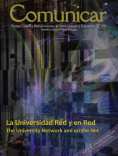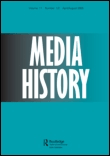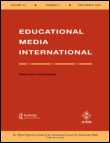
Media Education-Mediaobrazovanie
Scope & Guideline
Pioneering Research in Media Literacy and Education
Introduction
Aims and Scopes
- Media Literacy and Education:
The journal emphasizes the development of media literacy across various educational levels, exploring methods and frameworks for integrating media education into curricula. - Cultural Representation in Media:
A key focus area is the analysis of how different cultures and identities are represented in media, including cinema, television, and digital platforms, and the implications of these representations for society. - Impact of Digital Media:
The journal investigates the effects of digital media on communication, information dissemination, and social interaction, particularly in the context of education and youth engagement. - Historical and Critical Analysis of Media:
It includes historical studies and critical analyses of media practices, focusing on the evolution of media forms and their societal impacts, particularly in Russian and global contexts. - Innovations in Media Practices:
The journal seeks to highlight innovative practices in media education and the use of emerging technologies, such as AI and social media, in teaching and learning environments. - Interdisciplinary Approaches to Media Studies:
The journal encourages interdisciplinary research that combines insights from sociology, psychology, cultural studies, and communication to understand media's role in contemporary society.
Trending and Emerging
- Social Media and Empowerment:
Recent publications emphasize the role of social media as a tool for empowerment, particularly among marginalized groups, highlighting its potential in activism and social change. - COVID-19 and Media Impact:
The pandemic has triggered a surge in studies examining the role of media during crises, focusing on communication strategies, misinformation, and the adaptation of media education to online platforms. - Digital Media Literacy:
There is a growing focus on digital media literacy, exploring how individuals navigate complex digital environments and the skills necessary to critically engage with online content. - Cultural Identity and Representation:
Emerging themes include the exploration of cultural identities in media, particularly how diasporic communities are represented and how they engage with media narratives. - Innovative Educational Technologies:
The integration of innovative technologies, such as AI and generative networks in educational practices, is gaining traction, reflecting a shift towards modernizing media education methodologies.
Declining or Waning
- Traditional Media Criticism:
There has been a noticeable decline in traditional forms of media criticism, particularly those focused solely on historical perspectives without a contemporary lens. This suggests a shift towards more dynamic and current analyses of media. - Soviet Cinema Studies:
Research specifically focused on Soviet cinema appears to be waning, potentially indicating a broader interest in current global cinema trends and representations rather than historical analyses. - Print Media Education:
As digital media continues to dominate, the focus on print media education and its methodologies has decreased, reflecting the changing landscape of media consumption. - Gender Studies in Media:
While gender representation remains important, specific studies on gender issues in media are less frequent, possibly overshadowed by broader discussions of identity and intersectionality. - Local Media Studies:
There seems to be a decline in studies focused on local or regional media contexts, as the journal increasingly emphasizes global and transnational media influences.
Similar Journals

Vestnik Moskovskogo universiteta. Seriya 10. Zhurnalistika
Fostering Critical Perspectives in Journalism EthicsVestnik Moskovskogo universiteta. Seriya 10. Zhurnalistika, published by the prestigious M V Lomonosov Moscow State University, serves as a vital conduit for scholarly discourse in the fields of journalism and communication. With an ISSN of 0320-8079 and an E-ISSN of 0320-8079, the journal showcases rigorously peer-reviewed research and theoretical contributions that span diverse aspects of media studies, social communication, and journalism ethics. As of 2023, it is classified within the Q3 category in both Communication and miscellaneous Social Sciences, ranking #372 out of 511 and #445 out of 604, respectively, indicating its growing influence and relevance in these crucial academic domains. Despite not being Open Access, researchers and students alike can leverage the journal's valuable insights, which continue to shape contemporary understanding of media's impact on society. With a commitment to excellence and a focus on the rapidly evolving landscape of journalism, Vestnik Moskovskogo universiteta. Seriya 10. Zhurnalistika remains an essential resource for anyone looking to engage deeply with current debates and developments in the communication field.

Information Communication & Society
Advancing Knowledge in Communication and Information SciencesInformation Communication & Society, published by Routledge Journals, Taylor & Francis Ltd, is a premier journal in the fields of communication and library and information sciences, boasting an impressive impact factor and consistently high rankings in Scopus, including Rank #18/511 in Communication and Rank #14/280 in Library and Information Sciences for 2023. With its focus on the dynamic interplay between information technology and society, the journal serves as a vital platform for researchers, professionals, and students, facilitating the discussion of contemporary issues that shape digital environments. Since its inception in 2001 and converging from 2005 to 2024, the journal has maintained a rigorous peer-review process to ensure that it publishes high-quality research that contributes to ongoing debates and developments in the digital age. Although it does not offer open access, the journal's esteemed reputation and Q1 categorization underscore its impact within the academic community, making it an essential resource for anyone interested in the evolution of communication in the modern world.

Comunicar
Innovating dialogue in the realms of culture and learning.Comunicar is a prestigious academic journal published by Oxbridge Publishing House, focusing on the fields of Communication, Cultural Studies, and Education. Since its launch in 2002, the journal has operated under an Open Access model, ensuring that research is freely available to a global audience. Based in Spain, Comunicar has established itself as a leading publication, holding a Q1 ranking in 2023 across all its disciplines. It ranks in the top 1% of social sciences journals for Cultural Studies and Communication, and in the top 4% for Education, reflecting its significant impact and reach within these vital areas of study. The journal not only showcases innovative research but also promotes interdisciplinary dialogue, making it an essential resource for scholars, professionals, and students aiming to stay abreast of the latest developments in communication theory and practice.

Media History
Decoding the Impact of History on Modern MediaMedia History, published by Routledge Journals, Taylor & Francis Ltd, stands at the forefront of scholarship in the intersection of media, culture, and historical study. With a robust ISSN of 1368-8804 and E-ISSN of 1469-9729, this esteemed journal plays a vital role in advancing research across multiple disciplines, ranking notably in the top quartiles of Communication, Cultural Studies, and History categories as of 2023. Based in the United Kingdom, the journal aims to bridge the gaps between the past and present media narratives, providing researchers, professionals, and students with cutting-edge insights and critical analyses. While Media History does not currently offer open access options, its authoritative content remains crucial for those seeking to deepen their understanding of media evolution and its impact on contemporary society. As a highly respected publication, it serves as an essential resource for anyone interested in exploring how historical contexts shape media practices and perceptions.

ONLINE INFORMATION REVIEW
Exploring the Frontiers of Digital InformationONLINE INFORMATION REVIEW, published by Emerald Group Publishing Ltd, is a leading academic journal that focuses on the interdisciplinary areas of information science and technology, engaging extensively with topics related to information retrieval, digital information management, and user interaction with online content. With an impressive impact factor and a significant presence in the Q1 and Q2 categories across Library and Information Sciences and Computer Science Applications, this journal ranks among the top platforms for scholarly research, boasting a Scopus rank of #30 in Library and Information Sciences. Established in the UK, this journal has been pivotal since its inception in 1980, providing invaluable insights into the rapidly evolving landscape of online information systems. The journal offers both subscription and open access options, making its high-quality research accessible to a global audience. Researchers, professionals, and students alike will find this journal a critical resource for advancing knowledge and fostering innovation in the exploration of information technologies and their applications.

Television & New Media
Unraveling the Threads of Television and New MediaTelevision & New Media is a leading academic journal dedicated to the exploration of the intricate relationships between television, new media technologies, and contemporary culture. Published by SAGE Publications Inc, this journal boasts an impressive impact factor, placing it in the prestigious Q1 category for both Cultural Studies and Visual Arts and Performing Arts as of 2023. Its high rankings in Scopus—#8 in Visual Arts and Performing Arts and #24 in Cultural Studies—underscore its significance in the academic community, reflecting its robust contribution to the discourse on media and culture. Spanning from 2000 to 2024, the journal features cutting-edge research that offers insights into the evolving dynamics of media and its societal implications, making it an essential resource for researchers, professionals, and students alike. Although currently not open access, the journal ensures that its contents are accessible through academic libraries, facilitating the dissemination of knowledge in an ever-changing digital landscape.

Journal of Religion Media and Digital Culture
Advancing Scholarship in Digital Religious PracticesThe Journal of Religion Media and Digital Culture, published by BRILL, is a premier open-access academic journal that dives into the intersections of religion, media, and digital culture. Since its inception in 2014, it has established itself within the Q1 quartile of Religious Studies, holding an impressive ranking of #133 out of 644 in Scopus, placing it in the 79th percentile among its peers. The journal aims to facilitate critical discourse and innovative scholarship, making it an essential resource for researchers, professionals, and students interested in the dynamic ways that digital media influences religious practices and beliefs globally. With a commitment to high-quality research, the journal invites contributions that explore diverse methodologies and perspectives, as the impact of digital culture continues to reshape the landscape of religious communication. Located in Leiden, Netherlands, the journal addresses a broad international audience, promoting accessibility and inclusiveness in scholarship. Explore the rich contents of the Journal of Religion Media and Digital Culture to enrich your understanding and contributions to this evolving field.

JOURNAL OF BROADCASTING & ELECTRONIC MEDIA
Shaping the Future of Broadcasting ResearchThe JOURNAL OF BROADCASTING & ELECTRONIC MEDIA, published by Routledge Journals, Taylor & Francis Ltd, is a premier academic publication in the field of communication, officially recognized in the Q1 category for its exceptional quality and impact. With a rich history dating back to 1985, this journal serves as a vital platform for innovative research and critical discussions surrounding broadcasting and electronic media, addressing contemporary issues in digital communication, media technology, and audience studies. The journal boasts an impressive Scopus rank of #73 out of 511 in the Social Sciences - Communication category, placing it within the top 15% of its field. Researchers, professionals, and students alike benefit from its insightful articles that contribute to understanding the evolving landscape of media and communication. Although it does not currently operate under an Open Access model, its rigorous peer-review process ensures that published works meet high academic standards, sustaining its reputation as a cornerstone for scholarly discourse in the media industry.

Psychology of Popular Media
Revealing the Psychological Underpinnings of Media ConsumptionThe Psychology of Popular Media is a leading academic journal published by the Educational Publishing Foundation in collaboration with the American Psychological Association. With an ISSN of 2689-6567 and an E-ISSN of 2689-6575, this journal provides a critical platform for exploring the interplay between psychology and popular media forms from 2020 to 2024. Recognized for its quality, it holds impressive 2023 Scopus quartiles with Q2 rankings in Applied Psychology and Psychology (miscellaneous), alongside Q1 rankings in Communication and Cultural Studies, positioning it among the top-tier research outputs in these fields. The journal's robust analysis contributes significantly to understanding how media influences public perception and individual behavior, attracting contributions from distinguished researchers and students alike. Notably ranked in the top percentiles of Social Sciences – Cultural Studies and Psychology, it offers unparalleled insights into the psychological implications of media consumption. Researchers, professionals, and students in the fields of psychology, communication, and cultural studies will find this journal an invaluable resource for advancing their knowledge and understanding of contemporary media's impact.

Educational Media International
Connecting theory and practice in educational media.Educational Media International, published by Routledge Journals, Taylor & Francis Ltd, is a premier journal in the interdisciplinary fields of Communication and Education, with a commendable Q2 ranking in both categories as of 2023. Established in 1978, this journal serves as a significant platform for the dissemination of innovative research that explores the evolving intersection of media technologies and educational practices. With an emphasis on both theoretical and practical applications, it addresses crucial topics such as digital learning environments, multimedia educational resources, and the impact of social media on education, making it an essential resource for researchers, professionals, and students alike. Located in the United Kingdom, Educational Media International not only contributes to the academic discourse but also reflects global trends and challenges in education, fostering a deeper understanding of the vital role media plays in shaping learning experiences worldwide.